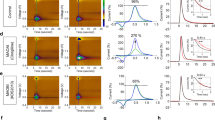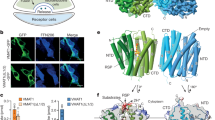Abstract
Exposuretol-methyl-4-phenyl-l,293,6-tetrahydropyridine(MPTP) reproduces certain clinical, pathological, and neurochemical features of Parkinson's disease1,7. MPTP is metabolized by monoamine oxidase Type B to l-methyl-4-phenylpyridine (MPP+)8, which is selectively accumulated by high-affinity uptake mechanisms into dopaminergic neurons9. Lyden et al.10 described low-affinity binding of MPTP to synthetic and retinal melanin. We showed that MPP+ binds to neuromelanin with high affinity11,12, suggesting that in MPTP neurotoxicity, MPP+ enters nigral neurons by the dopamine uptake system and binds to neuromelanin, which serves as a depot, continuously releasing MPP+ until it destroys the cells11. This model predicts that agents which compete with MPP+ binding to neuromelanin should partially protect the dopamine neurons from MPTP-induced toxicity. The most potent identified competitor for MPP+ binding to melanin is the antimalarial drug chloroquine12, which has a high affinity for melanins13. In the present study, chloroquine, administered to monkeys in conventional anti-malarial doses before MPTP, protects them from MPTP-induced parkinsonian motor abnormalities, dopamine depletion in the striatum, and neuropathological changes in the substantia nigra.
This is a preview of subscription content, access via your institution
Access options
Subscribe to this journal
Receive 51 print issues and online access
$199.00 per year
only $3.90 per issue
Buy this article
- Purchase on Springer Link
- Instant access to full article PDF
Prices may be subject to local taxes which are calculated during checkout
Similar content being viewed by others
References
1. Davis, G. C. et al. Psychiat. Res. 1, 249–254 (1979). 2. Langston, J. W., Ballard, P., Tetrud, J. W. & Irwin, I. Science 219, 979–980 (1983). 3. Burns, R. S. et al. Proc. natn. Acad. Sci. U.S.A. 80, 4546–4550 (1983). 4. Langston, J. W., Forno, L. S., Rebert, C. S. & Irwin, I. Brain Res. 292, 390–394 (1983). 5. Heikkila, R. E., Hess, A. & Duvoisin, R. C. Science 224, 1451–1453 (1984). 6. Hallman, H., Lange, J., Olson, L., Strombert, I. & Jonsson, G. /. Neurochem. 44, 117–127 (1985). 7. Kitt, C. A., Cork, L. C., Eidelberg, E., Job, T. H. & Price, D. L. Neuroscience 17,1089–1103 (1986). 8. Chiba, K., Trevor, A. & Castagnoli, N. Jr Biochem. biophys. Res. Commun. 120, 574–578 (1984). 9. Javitch, J. A., D'Amato, R. J., Strittmatter, S. M. & Snyder, S. H. Proc. natn. Acad. Sci. U.S.A. 82, 2173–2177 (1985). 10. Lyden, A., Bondesson, V., Larsson, B. S. & Lindquist, N. G. Acta Pharmac. Tox. 53,429–432 (1983). 11. D'Amato, R. J., Lipman, Z. P. & Snyder, S. H. Science 231, 987–989 (1986). 12. D'Amato, R. J., Benham, D. & Snyder, S. H. / Neurochem. 48, 653–658 (1987). 13.' Larson, B. & Tjalve, H. Biochem. Pharmac. 28, 1181 (1979). 14. Schwartzman, R. & Alexander, G. Brain Res. 358, 137–143 (1985). 15. Grundman, M., Mikulikova, I. & Urublousky, P. Archs int. Pharmacodyn. 197,45–52 (1972). 16. McChesney, E. W., Shekosky, J. M. & Hernandez, P. H. Biochem. Pharmac. 16, 2444–2447 (1967). 17. Heikkila, R. E., Manzino, L., Cabbat, F. S. & Duvoisin, R. C. Nature 311, 467–469 (1984). 18. Fuller, R. W. & Hemrock–Leucke, S. K. Life Sci. 37, 1089–1096 (1985). 19. Langston, J. W., Irwin, I., Langston, E. B. & Forno, L. S. Science 225, 1480–1482 (1984). 20. DeDuve, C. et al. Biochem. Pharmac. 23, 2495–2530 (1974). 21. Lawwill, T., Appleton, B. & Altstatt, L. Am. J. Ophthal. 65, 530–532 (1968). 22. Lyden, A., Bondesson, V., Larsson, B. S., Lindquist, N. G. & Olsson, L. I. Acta Pharmac. Tox. 57, 130–135 (1985). 23. Nicklas, W. J., Vyas, I. & Heikkila, R. E. Life Sci. 36, 2503–2508 (1985). 24. Bergqvist, Y. & Frisk–Holmberg, M. /. Chromat. 221, 119–127 (1980). 25. Nagatsu, T., Levitt, M. & Udenfriend, S. Analyt. Biochem. 9, 122–126 (1964). 26. Levine, R., Pollard, H. & Kuhn, D. Analyt. Biochem. 143, 205–208 (1984). 27. Coyle, J. Biochem. Pharmac. 21, 1935–1944 (1972).
Author information
Authors and Affiliations
Rights and permissions
About this article
Cite this article
D'Amato, R., Alexander, G., Schwartzman, R. et al. Evidence for neuromelanin involvement in MPTP-induced neurotoxicity. Nature 327, 324–326 (1987). https://doi.org/10.1038/327324a0
Received:
Accepted:
Issue Date:
DOI: https://doi.org/10.1038/327324a0
This article is cited by
-
Neuroprotective role of chloroquine via modulation of autophagy and neuroinflammation in MPTP-induced Parkinson’s disease
Inflammopharmacology (2023)
-
Melanin and neuromelanin binding of drugs and chemicals: toxicological implications
Archives of Toxicology (2016)
-
Molecular mechanisms of dopaminergic subset specification: fundamental aspects and clinical perspectives
Cellular and Molecular Life Sciences (2014)
-
Melanin affinity and its possible role in neurodegeneration
Journal of Neural Transmission (2013)
-
Differential effects of dopamine melanin on norharman-induced toxicity in PC12 cells
Journal of Neural Transmission (2007)
Comments
By submitting a comment you agree to abide by our Terms and Community Guidelines. If you find something abusive or that does not comply with our terms or guidelines please flag it as inappropriate.



